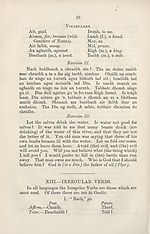Books and other items printed in Gaelic from 1871 to 1900 > Elementary lessons in Gaelic
(33) Page 27
Download files
Complete book:
Individual page:
Thumbnail gallery: Grid view | List view

27
teU, Infill., innse or innseadh; seachaiii, avoid, Infin., seach-
nadh.
2. Some have the Infinitive like the root, as—01, drink,
Infin., ol. Such are—Fas, grow, become; snamh, sunm ;
ruith, ru7i.
3. Many Verbs in air add t for the Infinitive, as—■
Tabhair, give, tabhairt.
4. Some Monosyllables add sinn or tinn, as—Creid,
believe, creidsinn ; bean, touch, beantuinn.
5. A few add ail, as—Fkg, leave, fagail.
Other irregulars will be noticed as they occur.
Av^iliaries.
Besides the Verb to be, dean, do, and rach, go, are used as
Auxiliary Verbs, as—Nach dean tbu bhualadh 1 will you
not (do his striking) strike him 1 rach a dh' 61, go to drink.
Impersonal Verbs.
Verbs which do not regularly admit of of a Passive Voice
are employed in the 3d Fers. Sing. Passive, with an Active
signification, and without an expressed Nominative, as—Cha
'n fhasar olc gu h-obainn, (one) does not become wicked all of
a sudden; thair ag innse dhomhsa, they tell me.
The Passive Voice is sometimes used in poetry, or for the
sake of efl'ect, as an Active Verb of the Present Tense with¬
out a Nominative, as—Tuitear sios chum an lar, down (he)
fell to the ground.
Many Gaelic Verbs are made up of Nouns, Adjectives,
and Prepositions, with the Auxiliary Verb to be, as—
Is f hearr leam (it is better with me), / 'prefer.
Tha agam (there is with me), I have.
Tha duil againn, we suppose.
Tha suil agam, / expect.
Tha agam air, he owes me.
Is beag orm, / dislike.
Cha 'n eil agam air, / dorit care for.
Is toigh leam, I like or love, &c.
These may be conjugated with the parts of the Verb to
be and the several Prepositional Pronouns.
teU, Infill., innse or innseadh; seachaiii, avoid, Infin., seach-
nadh.
2. Some have the Infinitive like the root, as—01, drink,
Infin., ol. Such are—Fas, grow, become; snamh, sunm ;
ruith, ru7i.
3. Many Verbs in air add t for the Infinitive, as—■
Tabhair, give, tabhairt.
4. Some Monosyllables add sinn or tinn, as—Creid,
believe, creidsinn ; bean, touch, beantuinn.
5. A few add ail, as—Fkg, leave, fagail.
Other irregulars will be noticed as they occur.
Av^iliaries.
Besides the Verb to be, dean, do, and rach, go, are used as
Auxiliary Verbs, as—Nach dean tbu bhualadh 1 will you
not (do his striking) strike him 1 rach a dh' 61, go to drink.
Impersonal Verbs.
Verbs which do not regularly admit of of a Passive Voice
are employed in the 3d Fers. Sing. Passive, with an Active
signification, and without an expressed Nominative, as—Cha
'n fhasar olc gu h-obainn, (one) does not become wicked all of
a sudden; thair ag innse dhomhsa, they tell me.
The Passive Voice is sometimes used in poetry, or for the
sake of efl'ect, as an Active Verb of the Present Tense with¬
out a Nominative, as—Tuitear sios chum an lar, down (he)
fell to the ground.
Many Gaelic Verbs are made up of Nouns, Adjectives,
and Prepositions, with the Auxiliary Verb to be, as—
Is f hearr leam (it is better with me), / 'prefer.
Tha agam (there is with me), I have.
Tha duil againn, we suppose.
Tha suil agam, / expect.
Tha agam air, he owes me.
Is beag orm, / dislike.
Cha 'n eil agam air, / dorit care for.
Is toigh leam, I like or love, &c.
These may be conjugated with the parts of the Verb to
be and the several Prepositional Pronouns.
Set display mode to:
![]() Universal Viewer |
Universal Viewer | ![]() Mirador |
Large image | Transcription
Mirador |
Large image | Transcription
Images and transcriptions on this page, including medium image downloads, may be used under the Creative Commons Attribution 4.0 International Licence unless otherwise stated. ![]()
| Rare items in Gaelic > Books and other items printed in Gaelic from 1871 to 1900 > Elementary lessons in Gaelic > (33) Page 27 |
|---|
| Permanent URL | https://digital.nls.uk/106251478 |
|---|
| Description | Out-of-copyright books printed in Gaelic between 1631 and 1900. Also some pamphlets and chapbooks. Includes poetry and songs, religious books such as catechisms and hymns, and different editions of the Bible and the Psalms. Also includes the second book ever published in Gaelic in 1631. |
|---|

